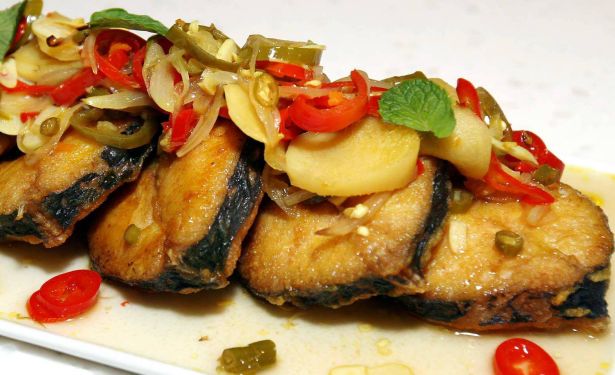This Korean fine-dining restaurant offers authentic dishes cooked by experts.
WHO can resist an invitation to Onsemiro, the only Korean fine-dining restaurant in town? Not me or a whole bunch of media friends who braved the after-five traffic jam and rain to show up for the Korean Air Appreciation Night at the restaurant recently.
As we sat down at an L-shaped table, little did we know that we would dine like kings and queens. The night’s menu was special: dishes served to the royalty in the past.
“We hired certified chefs who graduated from culinary schools and have experience from Korea,” explained Yuni Kim, general manager of Onsemiro.
She added: “Food, silverware and porcelain designer dishes are selected to propagate the Korean food and culture internationally. Ingredients are also imported from Korea to keep the food authentic and of top quality.”

Unless you are allergic to seafood, you must try this prawn, squid and green onion pancake.
Every Korean meal has two to 12 side dishes including kimchi (a traditional Korean dish made of fermented vegetables with a variety of seasonings). For starters, we had eight types of banchan (or side dishes). We learnt that these servings are unlimited, refillable (no kidding) and seasonal. We had spicy cabbage kimchi, white kimchi (non-spicy) and six other seasonal side dishes that day. Except for spicy kimchi, the other side dishes vary daily at the restaurant.
The Jabchae, or stir-fried glass noodles and vegetables, was flavourful and had the nice aroma of sesame oil.
We also had seafood (prawn and squid) and green onion pancakes called haemul-pajeon. You eat it with a dipping sauce (yang-nyum-jan) which is made with soya sauce, sugar, sesame seeds and chilli powder.
Similar to Chinese pancakes, they were quite filling for rumbling tummies. Refei Redzuan, Korean Air corporate marketing & PR, thought it tasted like cucur udang (Malay-style fried prawn fritters).
Kujul pang (miniature spring rolls) used to be served to kings and royal families. They are the size of a 50-sen coin and are eaten with seven types of fillings. They look like our popiah but are very delicate. This was certainly a novelty dish.
Gujeolpan (or Kujul Pang) is composed of three hanja words: gu (nine), jeol (section), and pan (plate) in Korean, explained Kim.
“There are traditionally eight different kinds of fillings, including meat, vegetables and in the centre of the tray is a stack of small jeon (Korean style pancakes) made with wheat flour, which are called miljeonbyeong,” she said.
Hobak-juk (hobak means pumpkin and juk, porridge) resembles cooked pumpkin puree garnished with a slice of red date. A starter, it is a smooth, sweet porridge which I quickly finished. The taste? Just like the one I tasted in a fine Korean restaurant in Seoul not so long ago.
The refreshing, citrusy Yuja Salad is a toss of mixed spring salad, lettuce, shrimp, squid, apple and almond flakes with yuja (Korean citron or lemon) dressing. It was very popular with the guests and I only managed to get a couple of slices of apple and a piece of squid.
Some of us had makkoli, the milky rice wine, which is a traditional alcoholic beverage in Korea. It is made by fermenting boiled rice and water, and contains 6% to 8% alcohol. It was a toast to wonderful times.

Hobak-juk, garnished with a slice of red date, is sweet and smooth.
“Makkoli was originally quite popular among farmers, earning it the name nongju (farmer’s liquor). However, it has recently become more popular in cities, especially with the younger generation,” Kim explained.
Gwang Yang Bulgogi (sirloin) and Yangnyeom Galbi (beef ribs) on a hotplate were marinated in the chef’s signature sauce. The sauce is a secret recipe and supposedly comprises 50 very special ingredients. The meat was wrapped with leafy greens and was delectable.
The stew, Buhsut-Jeongol, comes in a special hotpot. The warm bowl of beefy goodness (beef slices, mushrooms, cabbage, green onions, rice cake in beef stock) is comforting on a cold, rainy night.
Our meal continued with Bibimbap Rolls. They are much like Hainanese rice balls and were created in September for last year’s Malaysia International Gourmet Festival (MIGF).
We also savoured Onsemiro’s signature MIGF dessert menu. The traditional Korean desserts were Sujeonggwa (sweet fruit punch made from dried persimmon), Kyungdan (rice cake with walnut and red bean filling) and Ice Hongsi (persimmon sorbet), and they were presented on a long wooden platter.





